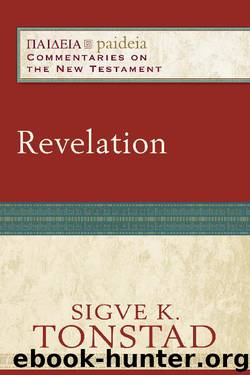Revelation by Sigve K. Tonstad

Author:Sigve K. Tonstad [Tonstad, Sigve K.]
Language: eng
Format: epub
Tags: New Testament;Bible (Revelation—Commentaries);REL006070;REL006050;REL006000
Publisher: Baker Publishing Group
Published: 2019-09-29T00:00:00+00:00
In the OT, Babylon’s fall signifies that the danger is over (Isa. 21:9; Jer. 50:2). In Revelation, a similar-sounding announcement means that the danger is approaching the critical point. Revelation’s “Babylon” has ramifications akin to the “falling away” described in 2 Thessalonians (Tonstad 2007, 133–51). “Balaam” in Pergamum (Rev. 2:14) and “Jezebel” in Thyatira (2:20) are “insider” threats meant to put the church universal on notice. In his account of the “two witnesses” (11:3–6), John describes “the great city that is spiritually called Sodom and Egypt, where also their Lord was crucified” (11:8). Here John is not guilty of a memory lapse; he knows well where his Lord “was crucified.” His hyperbole is value laden, conveying ideological and theological collapse from within. Within the scenario of imitation, the dragon’s two “witnesses” (13:1, 11) are not raised up from outside, from virgin, imperial soil. They are the dragon’s remedy for the lack of success on his first try (12:13–17), recruited and groomed from within as proof that the dragon did better when he “went away” (12:18).
Revelation turns a host of historical references into metaphors. Such conceptions apply to “Babylon,” too. When the obituary is read over “Babylon” in Revelation, the closing sentence brings out the deed that clinches the verdict. “And in her was found the blood of prophets and of holy ones, and of all who have been killed with violence on the earth” (18:24). Rome is consequential and has innocent lives on its conscience, but it is not big enough to fit this measure of “Babylon.” Rome is guilty enough, but it is less guilty of persecution of believers in the first century than has commonly been assumed, and it is not guilty of the lives “of all who have been killed with violence on the earth” (18:24). For this, we need an entity that is transhistorical and climactic in ways Rome is not. And we need a phenomenon that was born and bred to be good but now is “fallen”—and “fallen” indeed.
The Third Angel (14:9–11)
To understand the third angel, the context matters more than ever (14:9–10). John says that the three messengers follow each other (14:8–9). This suggests thematic, situational, and referential continuity. The threefold sequence builds toward a climax—beginning with the “critical moment” announced by the first angel (14:7). When the second angel announces that “Babylon the Great” is “fallen,” it does not signal that “Babylon” has ceased to be a threat. On the contrary, the threat represented by “Babylon” consists precisely of the fact that it is “fallen.”
John concludes his account of the two “witnesses” with the second “witness” causing “all—the small and the great, the rich and the poor, the free and the slaves—to be marked with a mark on the right hand or on the forehead” (13:16). God’s reaction does not beat around the bush with respect to the danger. If anyone worships the beast and his image and receives a mark on his/her forehead or on his/her hand, he/she will drink the wine of God’s wrath (14:9).
Download
This site does not store any files on its server. We only index and link to content provided by other sites. Please contact the content providers to delete copyright contents if any and email us, we'll remove relevant links or contents immediately.
| Guides | New Testament |
| Old Testament |
The Five People You Meet in Heaven by Mitch Albom(2844)
Name Book, The: Over 10,000 Names--Their Meanings, Origins, and Spiritual Significance by Astoria Dorothy(2494)
Real Sex by Lauren F. Winner(2479)
The Holy Spirit by Billy Graham(2420)
The Secret Power of Speaking God's Word by Joyce Meyer(2255)
0041152001443424520 .pdf by Unknown(2224)
How The Mind Works by Steven Pinker(2216)
ESV Study Bible by Crossway(2119)
Ancient Worlds by Michael Scott(2107)
The Meaning of the Library by unknow(2070)
The Gnostic Gospels by Pagels Elaine(2029)
Churchill by Paul Johnson(2014)
MOSES THE EGYPTIAN by Jan Assmann(1974)
The ESV Study Bible by Crossway Bibles(1936)
Jesus by Paul Johnson(1890)
The Nativity by Geza Vermes(1851)
Ancient Near Eastern Thought and the Old Testament by John H. Walton(1850)
The Complete Dead Sea Scrolls in English (7th Edition) (Penguin Classics) by Geza Vermes(1844)
City of Stairs by Robert Jackson Bennett(1828)
